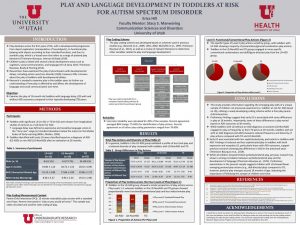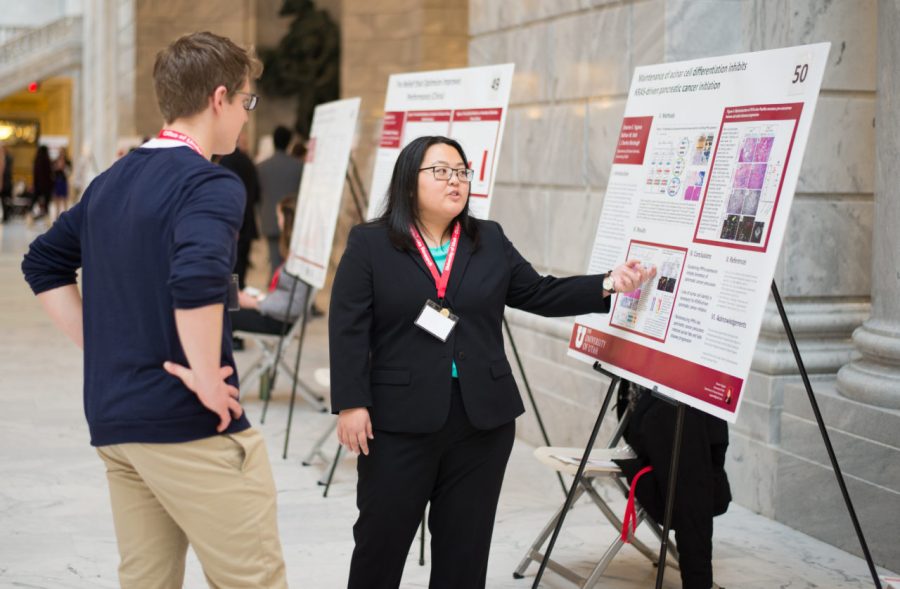The U Hosts Online Research Symposium
May 20, 2020
The University of Utah hosts an annual Undergraduate Research Symposium typically in the A. Ray Olpin Union Ballroom, where students can display their research and creative work from the year. The in-person symposium typically has around 300-500 students who attend, this year’s virtual symposium had 212 students participate.
Christina Trepanier, undergraduate research advisor, said they still wanted students to show off their research and work from the year despite the circumstances.
“This took a lot of creativity on our side! And a lot of trial and error. This could not have happened without everyone on our team coming up with ideas to make this possible,” she said.
Students submitted their research via a registration form and then presented their information through several formats — either oral, poster, performance, or visual arts.
“It also mimicked the in-person symposium in a sense. Some students do performances, some create posters, some exhibits, etc.,” Trepanier said, “The way we set it up allowed students to still be creative when presenting their research, which was the goal.”
Trepanier and Cindy Greaves, the Program Manager for the office of undergraduate research, uploaded them manually.
Marissa Castillo is a 2020 graduate from the U, where she majored in health promotion and education. Castillo chose the oral format to present her research on blood pressure variability in stroke patients. She could post a screen recording with a voiceover where she explains her project.
“I definitely think that it took away from the experience of being able to present in person, especially because it would have been my first time so I think that was a little disappointing having to miss that experience of it being live,” Castillo said.
Castillo chose the oral presentation because her mentor at the stroke center she works with has done many oral presentations at different national conventions.
“He thought it would be great for me to try that out here at the U so that when I start applying my research to other conventions, I’ll have experience doing that because he really would like me to continue to do oral presentations in the future. And I also thought it would be very fun and kind of pushing myself out of my comfort zone,” Castillo said.
Although online, Castillo believed the symposium allowed her to experience research and discover new career possibilities.
“I am planning on applying to medical school so that you know research opportunity really helps me in that way. Just getting that experience opened my eyes to more opportunities if I decided not to apply to med school or it didn’t work out or even if I wanted to continue research as a doctor,” Castillo said.
Erica Hill, a senior this fall, is majoring in speech and hearing sciences and minoring in ceramics. Hill completed her project on play and language development in toddlers on the autism spectrum.
“Yeah, I was planning on doing it in person. It was quite odd at first. It was very weird trying to present when you’re not really talking to anyone. I actually thought it turned out really well and I thought that it gave me a really awesome opportunity to present my research in a way that not many people think about,” Hill said.
Hill chose the poster format to present her research.
“I chose that mode because I thought it would give a good visual to all the work that I had done, and it would allow people to read my research along with me explaining it sort of summarizing the big picture,” Hill said.
While presenters provided their emails on their projects, some did not have the level of engagement they were expecting.

“I think the one thing I would have had them maybe do a little bit differently is encouraged professors to check out their students work more and maybe give some more constructive feedback; I think that will really help students, as we continue on with our careers to have some of that constructive feedback that we probably would have gotten if it was in an in-person symposium,” Hill said.
With the online format, though, students are able to view and comment on their peers’ projects perhaps more than they would have if they were presenting to people in real time.
“I can still go back and I can go and read through everyone’s research. It’s permanently there for people to check out people’s accomplishments and listen to what they have to say. And I think it gave a good opportunity to have even family members and friends be able to check out our research without having to come out to Utah,” Hill said.
Regardless of the format of the symposium, the opportunity to conduct and present research to professors and peers has been a beneficial experience.
“I think this symposium and this project has really given me the confidence in my future endeavors. I think now I am confident that I want to pursue a Ph.D. because of this, and I want to continue doing research and continue doing things where I can present my research, and hopefully make the world a little bit better,” Hill said.
While the virtual event was hosted on April 20, 2020, all research is still available to view on their website.








